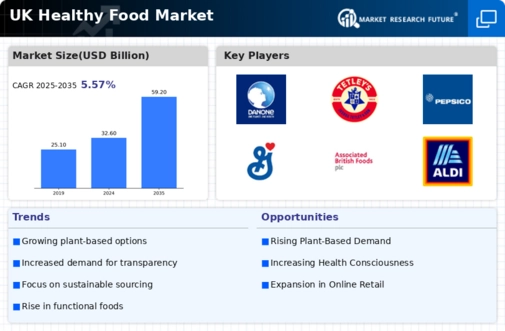Growing Health Consciousness
The increasing awareness of health and wellness among consumers is a primary driver of the healthy food market. In the UK, a notable shift towards healthier eating habits has been observed, with 63% of adults actively trying to improve their diet. This trend is reflected in the rising demand for organic and natural products, which are perceived as healthier options. The healthy food market is benefiting from this growing consciousness, as consumers seek products that align with their health goals. Furthermore, the emphasis on preventive healthcare is prompting individuals to invest in nutritious foods, thereby expanding the market. As a result, brands that promote health benefits and transparency in their offerings are likely to thrive in this evolving landscape.
Rise of E-commerce in Food Retail
The expansion of e-commerce platforms is reshaping the healthy food market, providing consumers with greater access to a variety of nutritious options. In the UK, online grocery sales have surged, with a reported increase of 76% in 2020, and this trend continues to influence purchasing behaviors. The healthy food market is capitalizing on this shift, as consumers increasingly prefer the convenience of online shopping for their dietary needs. E-commerce allows for a wider selection of products, including niche health foods that may not be available in traditional retail outlets. This accessibility is likely to drive growth in the market, as consumers seek out healthier alternatives from the comfort of their homes.
Sustainability and Ethical Consumption
The growing emphasis on sustainability and ethical consumption is significantly impacting the healthy food market. In the UK, consumers are increasingly concerned about the environmental and social implications of their food choices. A survey indicates that 72% of consumers prefer brands that demonstrate a commitment to sustainability. This trend is prompting the healthy food market to adopt more sustainable practices, such as sourcing ingredients responsibly and reducing packaging waste. As consumers seek transparency and ethical sourcing, brands that align with these values are likely to attract a loyal customer base. The intersection of health and sustainability is becoming a key driver, as individuals recognize the importance of making choices that benefit both their health and the planet.
Regulatory Support for Healthier Options
Government initiatives aimed at promoting healthier eating habits are significantly influencing the healthy food market. In the UK, policies such as the Soft Drinks Industry Levy and the introduction of food labeling regulations are encouraging manufacturers to reformulate products to reduce sugar and fat content. This regulatory environment is fostering innovation within the healthy food market, as companies adapt to meet new standards. The UK government has also launched campaigns to raise awareness about nutrition, further driving consumer interest in healthier food choices. As a consequence, brands that align with these regulations and promote their compliance are likely to gain a competitive edge, appealing to health-conscious consumers.
Influence of Social Media and Influencers
Social media platforms are playing a pivotal role in shaping consumer perceptions and preferences within the healthy food market. In the UK, influencers and health advocates are increasingly promoting nutritious food choices, which resonates with a younger demographic. This trend is evident as 54% of millennials report being influenced by social media when making food choices. The healthy food market is leveraging this phenomenon, with brands collaborating with influencers to enhance visibility and credibility. As consumers turn to social media for dietary inspiration, the demand for healthy products is likely to rise, driven by the aspirational lifestyles showcased online. This dynamic interaction between social media and consumer behavior is expected to continue influencing market trends.


























Leave a Comment